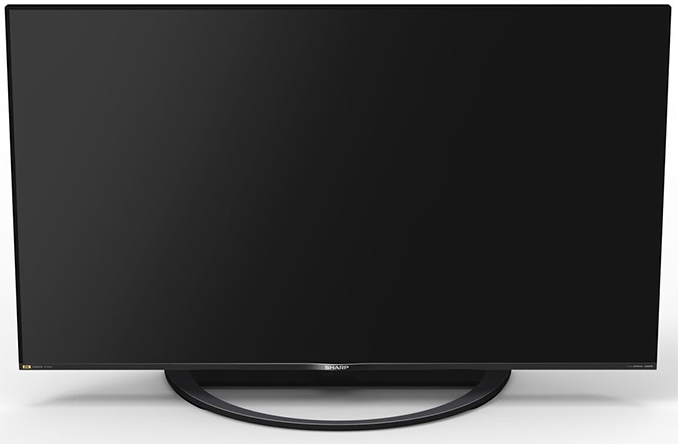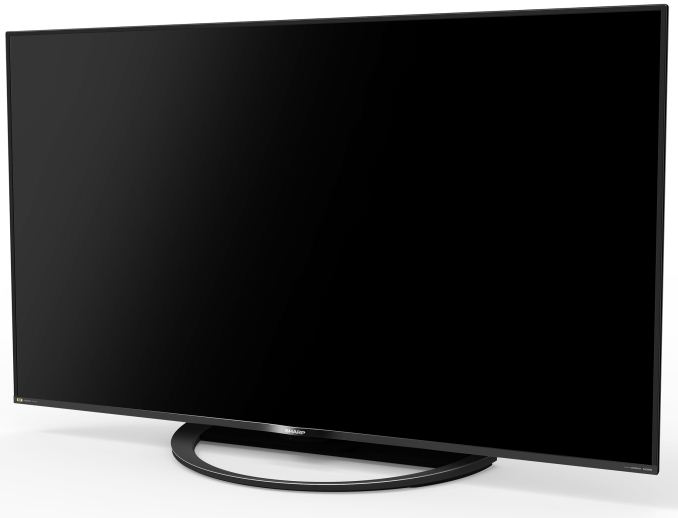Sharp Announces 2nd Gen 8K UHD TVs at IFA
by Anton Shilov on August 31, 2018 11:00 AM EST
Sharp this week introduced its second-generation 8K ultra-high def TVs at IFA in Berlin. The new televisions use the company’s new panels as well as the latest processors that can upscale Full-HD and Ultra-HD 4K content to a 7680×4320 resolution.
The initial lineup of Sharp’s 2nd Gen Aquos 8K UHD TVs will include models featuring sizes of 60, 70, and 80 inches. The new televisions will be based on the company’s new image processor that doubles its compute throughput over the predecessor and can upscale 2K as well as 4K content to an 8K resolution with a 100/120 Hz refresh rate.
The largest Aquos 8T C80AX1 80-inch flagship TV will rely on the company’s new UV2A II LCD (presumably IPS/IGZO) panel featuring a 100/120 Hz refresh rate, an “ultra-high brightness”, a “new wide color gamut”, and “high speed response”. The company does not quantify its claims, but it is logical to expect the new TV to be better than the existing Sharp Aquos LC-70X500E UHD TV that features a 400 nits typical brightness, a 1000 nits peak brightness for HDR (HDR10, HLG are supported), and an 8 ms GtG response time. Meanwhile, it is unclear whether a wider color gamut means a better coverage for the BT.2020 color gamut by a new 10-bit panel, or usage of a 12-bit panel.
Sharp plans to commercially launch its Aquos AX1-series 8K UHD TVs in Asia in late 2018 with European release sometimes in Q1 2019. The manufacturer said nothing about availability of its 2nd Gen 8K UHD TVs in the U.S., but since it calls the new family a “global 8K lineup”, it is logical to assume that the televisions will eventually be available in North America as well.
Related Reading:
- Sharp’s 8K UHD TV Available in Japan, Listed in Europe for €11,899
- CEATEC 2016: Sharp Showcases 27-inch 8K 120Hz IGZO Monitor with HDR, also 1000 PPI for VR
- Foxconn Takes Control of Sharp
Sources: Sharp, Technite-Video.de











49 Comments
View All Comments
austinsguitar - Friday, August 31, 2018 - link
unless this is 70' plus... 8k is just plain dumb tbh.Stochastic - Friday, August 31, 2018 - link
I think it could have a place in very large displays that are being used as PC monitors or for massive TVs, but 8K is going to remain super niche for a long time. It's only just now that we have the computing power and bandwidth to do 4k60 on most devices, and 4K120 is still a ways off.Valantar - Saturday, September 1, 2018 - link
For PC monitors? I suppose, but they'd either be for people doing photo work and similar intensely detailed visual work, or in huge sizes to fit a lot of information at once. 54" to replace 4 27" 4K monitors? Given that 4K is challenging to use at 100% scaling at 27", that would be the lower useful limit of such a use case.As for "massive TVs", no. There's no reason to get a TV so large that you have to move your head to see all of it, which means there's a limit to how large a TV most people can fit in their actual living rooms - and to how much people are willing to make TV placement the chief determinant of their interior design. For 8K to be useful (or even noticeable) for TVs, you'd need to be sitting very close to a very large TV, which is neither comfortable nor useful. Heck, at normal viewing distances the vast majority of people can't tell the difference between FHD and 4k on ~60" TVs. To make 8k a noticeable upgrade over 4k, you'd need a TV approaching 200" (which would be ~2.5m or 8' 2" tall - that's floor-to-ceiling in most homes, if not more).
PixyMisa - Sunday, September 2, 2018 - link
With a computer monitor, you can look more closely at something, so a 32" 8K monitor (like the one Dell sells already) makes perfect sense.With a TV you're supposed to take in the whole image, which is different.
niva - Tuesday, September 4, 2018 - link
That 80 inch display will be like 4 of the 40 inch 4k screens. These types of displays will be very useful in a number of fields such as anything that displays engineering data/telemetry, financial systems/market tracking, or anyone working on visual content creation.I'm personally not going to be able to afford one of these anytime soon, but this continues the match forward in technology.
surt - Monday, September 3, 2018 - link
You have to envision a future in which at _least_ one whole wall in your home is a walk-up touch display. It needs to have a resolution that makes sense at touch distance and wall scale.Manch - Tuesday, September 4, 2018 - link
I have a 50"(49.5" viewable...damn TV specs) 4k TV I use as a monitor. It does 4k@60/HDR so good enough for me. I previously had 3 24" 1080P Dells. I sit a bit back from the screen too.Pixel pitch, is marginally bigger so readability is the same. Great for games/CAD/visual work.
Still, I can see where an 8k monitor would be beneficial. NOT for gaming IMO. For some of the work I do, it would be nice.
Fallen Kell - Friday, August 31, 2018 - link
Agreed. Even then, if you are sitting 6 or more feet away, you still will not see the difference. I also wonder if the TV supports HDMI 2.2. If it doesn't, it is just another pass on the generation since it can't receive a source with 8k+HDR+Deep Color to take advantage of the display. It is like having a 800+ HP Ferrari engine on a car that only has a single fixed gear that will redline the engine well before taking full advantage of it's capabilities.nathanddrews - Friday, August 31, 2018 - link
I think you are confusing HDMI 2.1 (which is the latest HDMI spec featuring up to 48Gbps) and HDCP 2.2 (copy protection). But yeah, unless they state otherwise, assume that it does NOT support HDMI 2.1 so you'll be limited to 4K60 input. I hope that's not the case...nevcairiel - Saturday, September 1, 2018 - link
Ultra High Resolution TVs like that often have multiple inputs you can drive simultaneously. Of course thats another big headache to solve. The first gen Sharp 8K screens had quadruple HDMI that you could run to deliver 4 4K images to make up a 8K image.